Inhalt
Spiders lived with the dinosaurs!
 Please visit our website, www.garethstevens.com. For a free color catalog of all our high-quality books, call toll free 1-800-542-2595 or fax 1-877-542-2596.Cataloging-in-Publication Data
Please visit our website, www.garethstevens.com. For a free color catalog of all our high-quality books, call toll free 1-800-542-2595 or fax 1-877-542-2596.Cataloging-in-Publication Data Names: Dellaccio, Tanya. Title: Spiders lived with the dinosaurs! / Tanya Dellaccio. Description: New York : Gareth Stevens Publishing, 2017. | Series: Living with the dinosaurs | Includes index. Identifiers: ISBN 9781482456813 (pbk.) | ISBN 9781482456844 (library bound) | ISBN 9781482456820 (6 pack) Subjects: LCSH: Spiders--Juvenile literature.
Classification: LCC QL458.4 D45 2017 | DDC 595.44--dc23 First Edition Published in 2017 by Gareth Stevens Publishing 111 East 14th Street, Suite 349 New York, NY 10003 Copyright 2017 Gareth Stevens Publishing Designer: Laura Bowen Editor: Therese Shea Photo credits: Cover, p. (amber) Layne Kennedy/Getty Images. All rights reserved. No part of this book may be reproduced in any form without permission in writing from the publisher, except by a reviewer. Printed in the United States of America CPSIA compliance information: Batch #CW17GS: For further information contact Gareth Stevens, New York, New York at 1-800-542-2595. CONTENTS Words in the glossary appear in bold type the first time they are used in the text.
ANCIENT SPIDERS Spiders have lived on Earth for a very long time. Theyve been around for at least 380 million years! Did you know they existed at the same time the dinosaurs did? Even though dinosaurs are now , spiders have found ways to survive. Spider times. They give us a picture of what spiders were like among the dinosaursand before the dinosaurs. Theyre proof that spiders have always been incredible creatures! 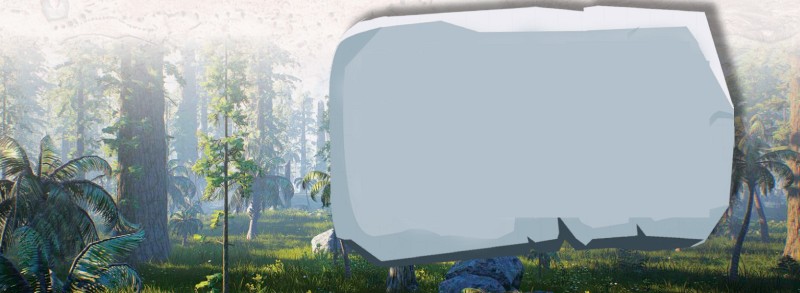 THE PREHISTORIC WORLD Spiderlike bugs date back to about 400 million years ago, but scientists dont think true spiders appeared until 380 million years ago.
THE PREHISTORIC WORLD Spiderlike bugs date back to about 400 million years ago, but scientists dont think true spiders appeared until 380 million years ago.  THIS FOSSIL, SHOWING A SPIDER ATTACKING A WASP, IS OVER 100 MILLION YEARS OLD! SO MANY LEGS! Spiders are part of the arachnid family.
THIS FOSSIL, SHOWING A SPIDER ATTACKING A WASP, IS OVER 100 MILLION YEARS OLD! SO MANY LEGS! Spiders are part of the arachnid family.
Many other eight-legged bugs belong in this group, including ticks, scorpions, and mites. Most arachnids are small. The spider Patu digua is just 15/1000 inch (0.38 mm) long, while the Goliath bird-eating spider has a leg span of up to 12 inches (30 cm)! The largest spider fossil thats been found is the prehistoric spider named Mongolarachne jurassica (mon-goh-luh-RAK-nee juh-RAA-sih-kuh). M. jurassicas body was 1 inch (2.5 cm) wide and its legs were 2.5 inches (6.4 cm) long. jurassica only hunted at night. jurassica only hunted at night.
This would have made it harder for predatorswhich probably included some dinosaursto see and catch it.  THIS FOSSIL BELOW SHOWS BOTH A MALE (LEFT) AND A FEMALE (RIGHT) M. JURASSICA. ITS THE LARGEST SPIDER FOSSIL FOUND YET, BUT SMALL COMPARED TO THE MODERN GOLIATH BIRD-EATING SPIDER. SUPERSILK Scientists have counted around 40,000 different species, or types, of spiders today. An that they all share is the ability to produce threads of silk, thanks to body parts called spinnerets.
THIS FOSSIL BELOW SHOWS BOTH A MALE (LEFT) AND A FEMALE (RIGHT) M. JURASSICA. ITS THE LARGEST SPIDER FOSSIL FOUND YET, BUT SMALL COMPARED TO THE MODERN GOLIATH BIRD-EATING SPIDER. SUPERSILK Scientists have counted around 40,000 different species, or types, of spiders today. An that they all share is the ability to produce threads of silk, thanks to body parts called spinnerets.
The silk is made of a kind of , which makes it very tough. Its also elastic, which means it has the ability to stretch without breaking. It can stretch to become about 30 percent longer than its original length. Spiders produce different kinds of silk for different purposes. Spiders wouldnt have survived without their silk! THE PREHISTORIC WORLD The Tasmanian cave spider is a species of spider alive today. Its thought to be directly related to prehistoric spiders!  SPIDER SILK IS THE STRONGEST MATERIAL MADE BY A LIVING THING.
SPIDER SILK IS THE STRONGEST MATERIAL MADE BY A LIVING THING.
THERE ARE AT LEAST SEVEN KINDS OF SPIDER SILK, THOUGH MOST SPIDERS CAN ONLY MAKE THREE OR FOUR. THE WEBS THEY WEAVE The most famous use of a spiders silk is its web, though only half of spider species make them. The oldest fossilized spider web is at least 130 million years old! A spiders sticky web traps prey flying or walking by. The spider then uses silk to wrap prey until the spider is ready to eat. Spiders mostly eat . 
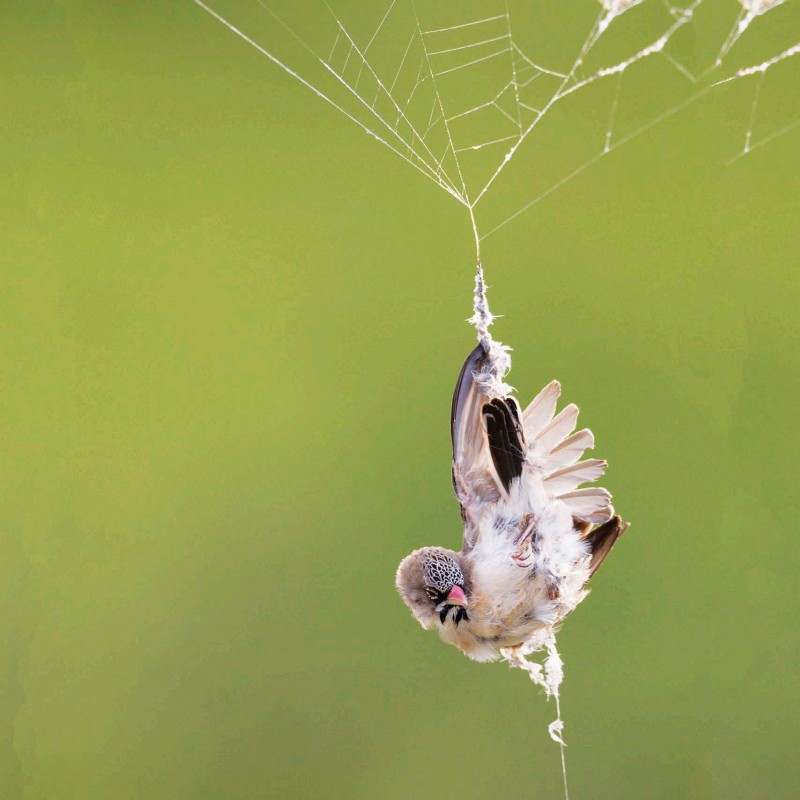 THIS BIRD GOT CAUGHT IN A SPIDER WEB.
THIS BIRD GOT CAUGHT IN A SPIDER WEB. 
 THIS BIRD GOT CAUGHT IN A SPIDER WEB.
THIS BIRD GOT CAUGHT IN A SPIDER WEB.
THE WEB-SPINNING ADAPTATION HAS HELPED SPIDERS SURVIVE AMONG LARGER, STRONGER ANIMALS. AMBUSH SPIDERS Not all spiders use webs to catch prey. Hunting spiders have good eyesight to find and capture prey. They use it, too. Jumping spiders are a kind of hunting spider that can leap 30 times the length of their own body onto their prey! Crab spiders are hunting spiders that use . They hide on flowers the same color as their body and wait for prey.
Scientists think the 300-million-year-old prehistoric spider called Cryptomartus hindi, or C. hindi, was like the crab spider. Both used their front legs to catchand crush!prey. 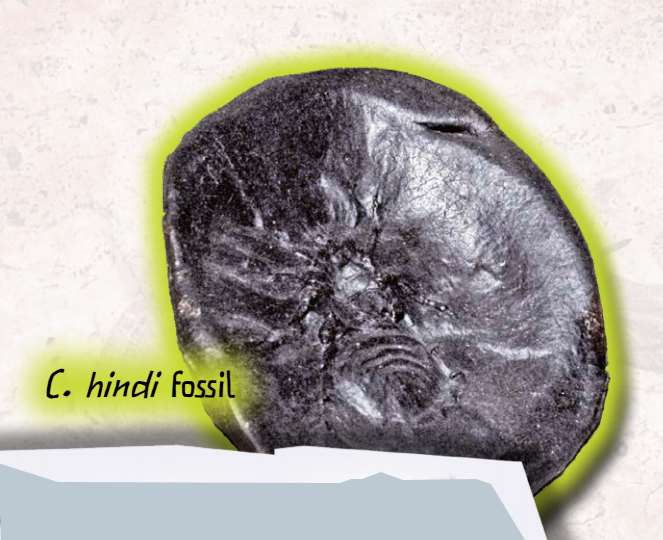 THE PREHISTORIC WORLD A spider called E. prestivicii lived before the dinosaurs, about 300 million years ago. It had spikes on its back, probably to scare amphibian predators!
THE PREHISTORIC WORLD A spider called E. prestivicii lived before the dinosaurs, about 300 million years ago. It had spikes on its back, probably to scare amphibian predators! 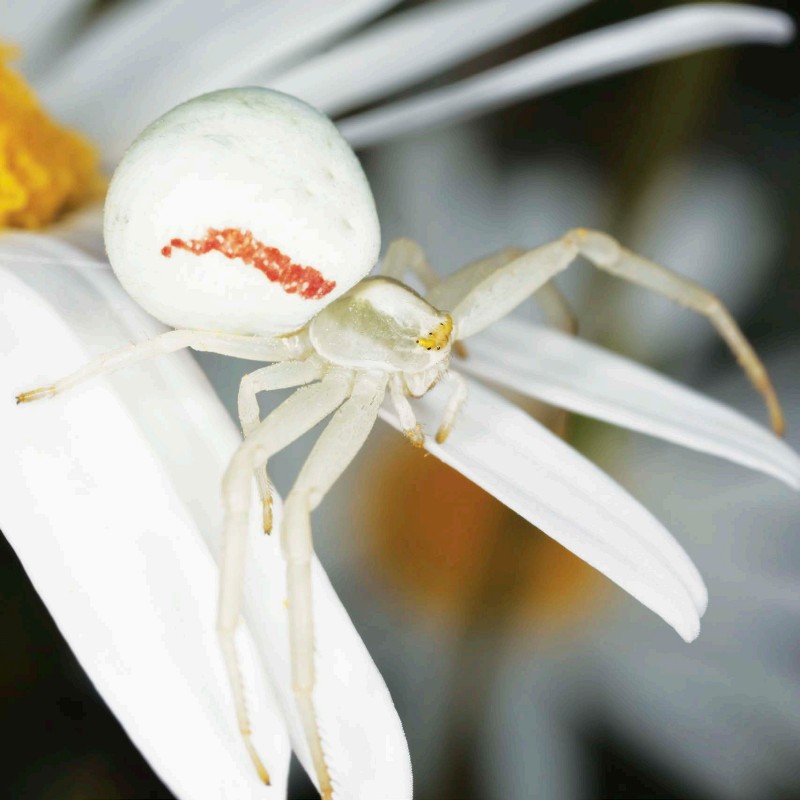 C.
C.
HINDI MIGHT HAVE LOOKED MUCH LIKE THIS CRAB SPIDER. SPIDER VISION A spider often has eight eyes, though some have six or fewer. While hunting spiders have good eyesight, most web-spinning spiders dont. They use other senses to make up for that, such as touch and taste. Spiders often use on their web and on the ground to tell them about the world. In fact, scientists have discovered that spiders pluck their web, then wait to feel the vibrations that come back.
The vibrations tell them if the web needs to be fixed and about prey stuck in it. THE PREHISTORIC WORLD Like many spiders, dinosaurs didnt have good eyesight. The Carcharodontosaurus (kar-kar-uh-don-tuh-SAWR-uhs) couldnt see well at all. Its thought that this meat eater hunted using its sense of smell!  MOST SPIDERS HAVE POOR EYESIGHT. HOWEVER, THEY HAVE SPECIAL LEGS THAT CAN SENSE VIBRATIONSAND EVEN SMELLS IN THE AIR! AND POISON, TOO All spiders have jaws called chelicerae (kuh-LIH-suh-ree). These jaws end in The fangs work like needles.
MOST SPIDERS HAVE POOR EYESIGHT. HOWEVER, THEY HAVE SPECIAL LEGS THAT CAN SENSE VIBRATIONSAND EVEN SMELLS IN THE AIR! AND POISON, TOO All spiders have jaws called chelicerae (kuh-LIH-suh-ree). These jaws end in The fangs work like needles.

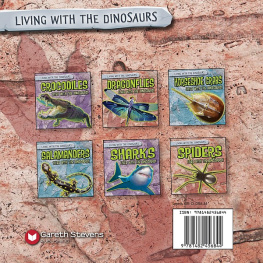

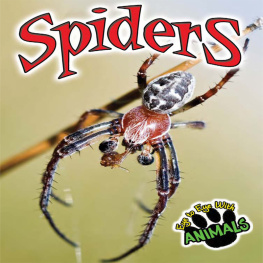


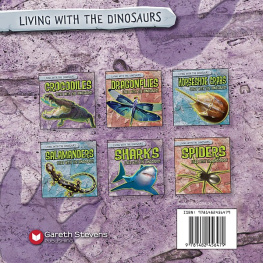


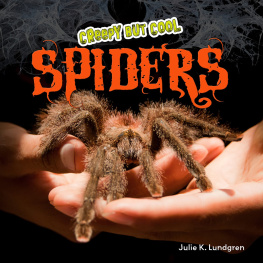

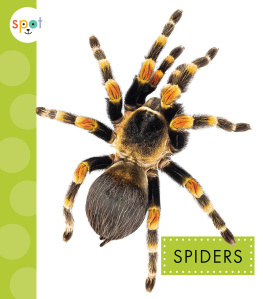
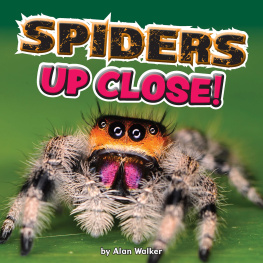
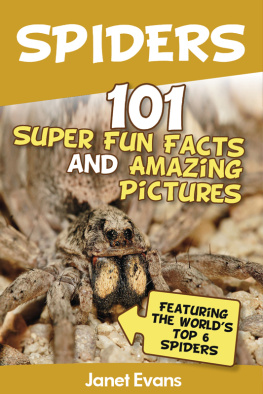

 Please visit our website, www.garethstevens.com. For a free color catalog of all our high-quality books, call toll free 1-800-542-2595 or fax 1-877-542-2596.Cataloging-in-Publication Data Names: Dellaccio, Tanya. Title: Spiders lived with the dinosaurs! / Tanya Dellaccio. Description: New York : Gareth Stevens Publishing, 2017. | Series: Living with the dinosaurs | Includes index. Identifiers: ISBN 9781482456813 (pbk.) | ISBN 9781482456844 (library bound) | ISBN 9781482456820 (6 pack) Subjects: LCSH: Spiders--Juvenile literature.
Please visit our website, www.garethstevens.com. For a free color catalog of all our high-quality books, call toll free 1-800-542-2595 or fax 1-877-542-2596.Cataloging-in-Publication Data Names: Dellaccio, Tanya. Title: Spiders lived with the dinosaurs! / Tanya Dellaccio. Description: New York : Gareth Stevens Publishing, 2017. | Series: Living with the dinosaurs | Includes index. Identifiers: ISBN 9781482456813 (pbk.) | ISBN 9781482456844 (library bound) | ISBN 9781482456820 (6 pack) Subjects: LCSH: Spiders--Juvenile literature.  THE PREHISTORIC WORLD Spiderlike bugs date back to about 400 million years ago, but scientists dont think true spiders appeared until 380 million years ago.
THE PREHISTORIC WORLD Spiderlike bugs date back to about 400 million years ago, but scientists dont think true spiders appeared until 380 million years ago.  THIS FOSSIL, SHOWING A SPIDER ATTACKING A WASP, IS OVER 100 MILLION YEARS OLD! SO MANY LEGS! Spiders are part of the arachnid family.
THIS FOSSIL, SHOWING A SPIDER ATTACKING A WASP, IS OVER 100 MILLION YEARS OLD! SO MANY LEGS! Spiders are part of the arachnid family. THIS FOSSIL BELOW SHOWS BOTH A MALE (LEFT) AND A FEMALE (RIGHT) M. JURASSICA. ITS THE LARGEST SPIDER FOSSIL FOUND YET, BUT SMALL COMPARED TO THE MODERN GOLIATH BIRD-EATING SPIDER. SUPERSILK Scientists have counted around 40,000 different species, or types, of spiders today. An that they all share is the ability to produce threads of silk, thanks to body parts called spinnerets.
THIS FOSSIL BELOW SHOWS BOTH A MALE (LEFT) AND A FEMALE (RIGHT) M. JURASSICA. ITS THE LARGEST SPIDER FOSSIL FOUND YET, BUT SMALL COMPARED TO THE MODERN GOLIATH BIRD-EATING SPIDER. SUPERSILK Scientists have counted around 40,000 different species, or types, of spiders today. An that they all share is the ability to produce threads of silk, thanks to body parts called spinnerets. SPIDER SILK IS THE STRONGEST MATERIAL MADE BY A LIVING THING.
SPIDER SILK IS THE STRONGEST MATERIAL MADE BY A LIVING THING.
 THIS BIRD GOT CAUGHT IN A SPIDER WEB.
THIS BIRD GOT CAUGHT IN A SPIDER WEB.  THE PREHISTORIC WORLD A spider called E. prestivicii lived before the dinosaurs, about 300 million years ago. It had spikes on its back, probably to scare amphibian predators!
THE PREHISTORIC WORLD A spider called E. prestivicii lived before the dinosaurs, about 300 million years ago. It had spikes on its back, probably to scare amphibian predators!  C.
C. MOST SPIDERS HAVE POOR EYESIGHT. HOWEVER, THEY HAVE SPECIAL LEGS THAT CAN SENSE VIBRATIONSAND EVEN SMELLS IN THE AIR! AND POISON, TOO All spiders have jaws called chelicerae (kuh-LIH-suh-ree). These jaws end in The fangs work like needles.
MOST SPIDERS HAVE POOR EYESIGHT. HOWEVER, THEY HAVE SPECIAL LEGS THAT CAN SENSE VIBRATIONSAND EVEN SMELLS IN THE AIR! AND POISON, TOO All spiders have jaws called chelicerae (kuh-LIH-suh-ree). These jaws end in The fangs work like needles.